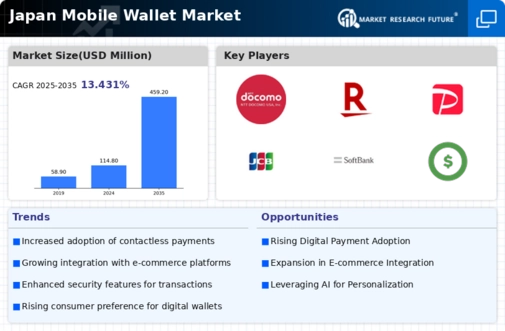Rising Smartphone Penetration
The mobile wallet market in Japan is experiencing significant growth due to the increasing penetration of smartphones. As of 2025, approximately 85% of the population owns a smartphone, facilitating the adoption of mobile wallet applications. This trend indicates a shift in consumer behavior, where individuals prefer the convenience of digital transactions over traditional cash payments. The integration of advanced features in smartphones, such as biometric authentication and NFC technology, further enhances the usability of mobile wallets. Consequently, this driver is pivotal in shaping the mobile wallet market, as it aligns with the growing demand for seamless and efficient payment solutions.
Increased Focus on User Experience
User experience is becoming a critical factor in the mobile wallet market, as providers strive to differentiate their offerings. Companies are investing in user-friendly interfaces and streamlined processes to enhance customer satisfaction. In 2025, it is estimated that 70% of mobile wallet users prioritize ease of use when selecting a payment method. This focus on user experience is likely to drive innovation within the mobile wallet market, as providers seek to create intuitive applications that cater to consumer preferences. Enhanced user experience may lead to higher adoption rates and increased transaction volumes.
Government Initiatives for Digital Payments
The Japanese government is actively promoting digital payment solutions, which significantly impacts the mobile wallet market. Initiatives aimed at increasing cashless transactions are evident, with the government setting a target to raise the cashless payment ratio to 40% by 2025. This policy framework encourages businesses and consumers to adopt mobile wallets, thereby fostering a conducive environment for growth. Furthermore, the government's collaboration with financial institutions to enhance digital infrastructure supports the expansion of mobile wallet services. Such initiatives are likely to drive consumer confidence and adoption rates in the mobile wallet market.
E-commerce Growth and Online Shopping Trends
The mobile wallet market is benefiting from the rapid growth of e-commerce in Japan. As online shopping continues to gain traction, consumers increasingly prefer mobile wallets for their convenience and security. In 2025, e-commerce sales in Japan are projected to reach ¥20 trillion, with a significant portion of transactions being conducted via mobile wallets. This trend suggests that as more consumers engage in online shopping, the demand for mobile wallet solutions will likely rise. Retailers are also integrating mobile wallet options to enhance customer experience, further propelling the mobile wallet market.
Partnerships with Retailers and Service Providers
Strategic partnerships between mobile wallet providers and retailers are emerging as a key driver in the mobile wallet market. Collaborations enable mobile wallets to offer exclusive discounts and promotions, incentivizing consumers to utilize these services. In 2025, it is anticipated that partnerships will account for 30% of mobile wallet transactions in Japan. This trend indicates that as more retailers adopt mobile wallet solutions, the market will likely expand. Such partnerships not only enhance the value proposition for consumers but also contribute to the overall growth of the mobile wallet market.


















Leave a Comment